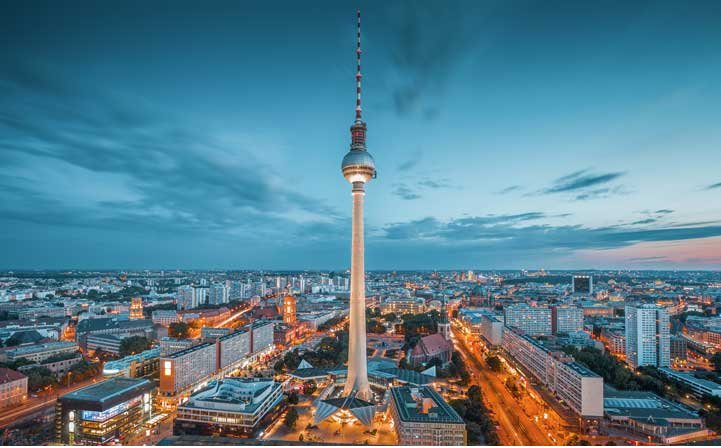Market in Minutes: World Cities Prime Residential Index

Marianne har jobbet som markedssjef i Malling & Co siden 2010. Hun er glødende opptatt av merkevarebygging basert på samspillet mellom markedsføring, CRM og ny teknologi. Marianne har over 25 års erfaring med markedsføring av næringseiendom men er utdannet profesjonell dykker og er verdens første kvinnelige metningsdykker. Når hun ikke tenker på markedsføring, er hun engasjert i byutvikling, ny teknologi og kultur.
Vår internasjonale samarbeidspartner Savills har lansert rapporten: Market in Minutes: World Cities Prime Residential Index.
Prime residential property in Berlin and Paris is in high demand

Berlin has the fastest-growing prime residential property prices
The slowdown seen across the world’s leading prime city housing markets during the second half of 2018 continued into 2019. The Savills World Cities Prime Residential Index rose by 0.4% in the first half of 2019, taking annual growth to 0.7%. This compares with an annual increase of 5.1% in the year to June 2018.
However, there are exceptions. The stand-out growth for prime residential property over the past year has been in Berlin and Paris, which have recorded a rise of approximately 8% each. Both markets have benefited from low supply levels and increasing demand from international and domestic buyers.
The six months to June 2019 marked a turning point for a number of Chinese cities as prices increased following falls during the second half of 2018. This follows a slight loosening of housing restrictions as the economy slows in response to internal and external factors.
A similar trend was seen in Moscow, as prices increased 1.2% in the first half of 2019 following years of price falls as Russian money returns to the capital.
In Kuala Lumpur and Bangkok, prime prices rose by nearly 2.5% in the first half of 2019, benefiting from international investment as prices are relatively low on the global stage.
New York, London, Sydney
Conversely, many US cities have seen prices fall over the first six months of 2019. Here, demand has been impacted by tax changes. The amount of state and local taxes that homeowners can deduct has been capped and the mortgage interest deduction was reduced from US$1 million to US$750,000 in mortgage debt. Additionally, in the case of New York and Miami, there are high levels of new build supply in the prime residential sector.
The impact of Brexit is still being felt in London, although the market is showing signs of levelling out as prices recorded their smallest fall since June 2014 as a shortage of stock in some markets is helping fuel demand.
The opposite is true in Sydney, as price falls accelerate following a change in mortgage regulations and increased taxes and restriction for international buyers.
Outlook
There are a number of reasons why the prime residential markets in global cities are going through a slowdown. Government policies, the cost of money, increased supply and global economic uncertainty have all contributed. Despite these headwinds, we do not except significant price falls across the Index, but that growth will remain flat or experience small increases in value over the medium term.
Prime residential values are underpinned by a fundamental gap in supply and demand. Land is often limited in global cities so demand in these desirable cities outstrips supply. It is expected that high net worth individuals will continue to want to hold one or more world city prime residential properties as part of their portfolio, both as a store of wealth and as a base for work and leisure.
Over the short term, we expect European cities to continue to outperform as they benefit from Brexit and comparatively lower prices. Over the longer term, wealth generation will be critical to the growth of each city’s prime residential market, along with political and economic stability and favourable demographics.
Motta rapporter og informasjon direkte i din e-post
Siste artikler
ARKIV
- desember 2025 (3)
- november 2025 (4)
- oktober 2025 (4)
- september 2025 (5)
- august 2025 (2)
- juli 2025 (3)
- juni 2025 (4)
- mai 2025 (2)
- april 2025 (6)
- mars 2025 (8)
- februar 2025 (5)
- januar 2025 (6)
- november 2024 (4)
- oktober 2024 (7)
- september 2024 (5)
- august 2024 (3)
- juli 2024 (3)
- juni 2024 (3)
- mai 2024 (4)
- april 2024 (3)
- mars 2024 (5)
- februar 2024 (5)
- januar 2024 (6)
- desember 2023 (3)
- november 2023 (6)
- oktober 2023 (5)
- september 2023 (1)
- august 2023 (4)
- juli 2023 (5)
- juni 2023 (4)
- mai 2023 (5)
- april 2023 (3)
- mars 2023 (3)
- februar 2023 (3)
- januar 2023 (5)
- desember 2022 (2)
- november 2022 (3)
- oktober 2022 (11)
- september 2022 (2)
- august 2022 (5)
- juli 2022 (4)
- juni 2022 (4)
- mai 2022 (1)
- april 2022 (5)
- mars 2022 (5)
- februar 2022 (3)
- januar 2022 (5)
- desember 2021 (2)
- november 2021 (5)
- oktober 2021 (3)
- september 2021 (3)
- august 2021 (2)
- juli 2021 (1)
- juni 2021 (8)
- mai 2021 (2)
- april 2021 (1)
- mars 2021 (5)
- februar 2021 (4)
- januar 2021 (7)
- desember 2020 (5)
- november 2020 (4)
- oktober 2020 (5)
- september 2020 (4)
- august 2020 (3)
- juli 2020 (4)
- juni 2020 (5)
- mai 2020 (5)
- april 2020 (4)
- mars 2020 (7)
- februar 2020 (3)
- januar 2020 (4)
- desember 2019 (4)
- november 2019 (4)
- oktober 2019 (4)
- september 2019 (4)
- august 2019 (4)
- juli 2019 (6)
- juni 2019 (6)
- mai 2019 (5)
- april 2019 (5)
- mars 2019 (3)
- februar 2019 (4)
- januar 2019 (6)
- november 2018 (6)
- oktober 2018 (4)
- september 2018 (5)
- august 2018 (1)
- juli 2018 (1)
- juni 2018 (4)
- mai 2018 (5)
- april 2018 (6)
- mars 2018 (1)
- februar 2018 (2)
- januar 2018 (4)
- desember 2017 (5)
- november 2017 (5)
- oktober 2017 (3)
- september 2017 (3)
- august 2017 (2)
- juli 2017 (1)
- juni 2017 (1)
- mai 2017 (6)
- april 2017 (5)
- mars 2017 (5)
- februar 2017 (2)
- januar 2017 (8)
- november 2016 (2)
- september 2016 (2)
- august 2016 (1)
- april 2016 (2)
- januar 2016 (1)
- november 2015 (2)
- september 2015 (2)
- august 2015 (1)
- juni 2015 (3)
- mai 2015 (1)
- april 2015 (1)
- mars 2015 (1)
- februar 2015 (2)
- januar 2015 (1)
- november 2014 (2)
- november 2013 (2)
- oktober 2013 (2)
- august 2013 (1)
- juli 2013 (1)
- juni 2013 (2)
- desember 2012 (1)
- november 2012 (1)
- september 2012 (1)
- juni 2012 (1)
- mai 2012 (1)
- desember 2011 (1)
- september 2011 (2)
- august 2011 (2)
- mars 2011 (1)
- desember 2010 (1)
- november 2010 (2)
- oktober 2010 (1)
- desember 2009 (1)
- november 2009 (1)
- mars 2009 (4)
- januar 2009 (1)
- desember 2008 (1)
- mai 2008 (1)
- desember 2007 (2)
- november 2007 (1)
- september 2007 (1)
- juli 2007 (1)
- mai 2007 (1)
- april 2007 (1)
- november 2006 (1)
- oktober 2006 (1)
- september 2006 (1)
- juni 2006 (1)
- april 2006 (1)
- februar 2006 (1)
- februar 2005 (1)








